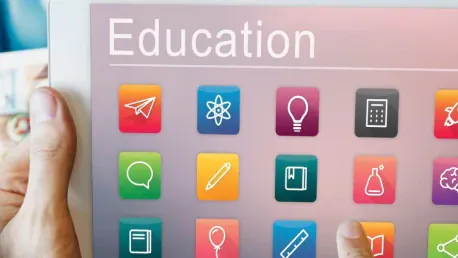In today’s digital age, educational apps have revolutionized the way we learn and teach. These innovative tools cater to diverse audiences, from toddlers to professionals, engaging users through interactive and personalized content. This article provides an in-depth exploration of the costs and strategies involved in developing these powerful educational platforms.
Key Factors Influencing the Cost of Educational App Development
App Complexity and Features
Educational apps come in various complexities, ranging from simple flashcard applications to intricate platforms with Artificial Intelligence-driven learning paths. Basic educational apps tend to be less expensive due to their limited features and simpler architecture. In contrast, more complex apps that incorporate advanced functionalities such as live streaming, gamification elements, and 3D simulations require a significant investment in terms of both financial resources and time.
Incorporating customizable educational content into the app significantly drives up the costs, but it also enhances user engagement and effectiveness. Custom content allows educators to tailor lessons to meet diverse learning needs, thereby increasing the app’s value proposition. The primary consideration here is balancing the advanced capabilities with the user’s need to create an enriching learning experience. Developers and educators should carefully plan the app’s features to ensure they offer meaningful interactions without unnecessarily complicating the app’s usability.
Platform Choice
Choosing the right platform for your educational app is crucial for reaching your target audience and managing development costs effectively. Developing an app exclusively for a single platform, such as iOS or Android, is generally cheaper and faster, but it limits the app’s potential user base. Conversely, opting for cross-platform development can be more cost-effective in the long run, as it allows for broader market reach. Technologies like React Native or Flutter enable developers to create apps that run seamlessly on multiple platforms, thereby maximizing user engagement and optimizing costs.
However, cross-platform development can introduce its own set of challenges, such as ensuring consistent performance across different operating systems and device specifications. To mitigate these risks, it is advisable to conduct thorough testing on various devices and make necessary adjustments to achieve uniform user experience. The strategic choice of platform should align with your target demographic and their preferred devices, thereby ensuring the app’s relevance and accessibility.
Essential Elements and Premium Features
Tech Stack and Development Tools
The choice of technology stack and development tools is a significant factor impacting the overall development cost and app performance. High-end technology stacks often require specialized skills, which can lead to higher expenditure but ensures superior performance and scalability. Employing scalable technologies such as .NET, Blazor, and React for the app’s backend and frontend can manage long-term development costs and foster efficient app scalability.
A well-chosen tech stack can offer efficiencies that outweigh the initial investment. For instance, using a robust backend platform can handle high loads and complex operations, ensuring a smoother user experience as the app scales. Developers must consider future growth and evolving needs by selecting technologies that are not only effective now but also adaptable for future updates and enhancements. Ongoing collaboration between developers and educators is essential in identifying the tools that best serve the educational objectives while maintaining cost-effectiveness.
Design and User Experience
Investing in high-quality, intuitive design is pivotal for attracting and retaining users in an educational app. Aesthetically pleasing and user-friendly interfaces demand more resources and expertise, but they significantly enhance user satisfaction and app usability. The primary goal is to create an interface that is both visually appealing and functional, facilitating smooth navigation and effective learning interactions. Designers should focus on balancing visual appeal with functionality, ensuring that the design supports educational objectives without overwhelming the user.
User experience (UX) design plays a critical role in determining the app’s success. Elements such as easy navigation, clear instructions, and engaging visuals can dramatically improve user retention and learning outcomes. Incorporating user feedback during the design process can provide valuable insights into real-world usage and help refine the app accordingly. A thoughtfully designed educational app not only attracts users but also fosters long-term engagement, driving repeated use and higher satisfaction rates.
Location, Team, and Third-Party Integrations
Location of Development Team
The geographical location of your development team can dramatically affect the overall cost of developing an educational app. Onshore developers, particularly those based in North America or Western Europe, tend to be more expensive compared to their offshore counterparts in regions like Eastern Europe, India, or Southeast Asia. However, it is crucial to balance cost with quality to ensure a high return on investment. Hiring a skilled and reliable team, regardless of their location, is essential for developing a top-notch educational app.
Offshore development teams can offer competitive rates while maintaining high technical standards, making them an attractive option for budget-conscious projects. However, effective communication and project management are critical to ensure that the project stays on track and meets the desired quality standards. Utilizing collaboration tools and setting clear expectations can help mitigate potential challenges. Thorough due diligence in selecting an offshore partner, coupled with strong project oversight, can result in significant cost savings without compromising on quality.
Third-Party Integrations
Integrating third-party services like payment gateways, social media APIs, and analytics tools adds functionality to the educational app but also increases complexity and development costs. These integrations can streamline user experience and provide valuable insights, making them worthwhile investments. For instance, incorporating analytics tools can help track user engagement and learning progress, enabling data-driven decisions to enhance the app’s effectiveness. Payment gateways are essential for apps offering premium content or subscription models, providing a seamless and secure transaction process.
Careful planning and selection of essential integrations can help manage costs without compromising on user experience. Developers should prioritize integrations that deliver the most value to users while aligning with the app’s primary objectives. Additionally, ensuring seamless integration and compatibility with existing systems is crucial for maintaining a smooth user experience. By focusing on strategic integrations, developers can enhance the app’s functionality and user satisfaction, driving long-term success.
Compliance, Security, and Content Creation
Compliance and Security Requirements
Educational apps, particularly those used by minors, must adhere to stringent regulations such as the Children’s Online Privacy Protection Act (COPPA) and the General Data Protection Regulation (GDPR). Ensuring compliance with these regulations and implementing robust security measures to protect user data are non-negotiable, adding to development costs but safeguarding user trust and the app’s reputation. Compliance involves a thorough understanding of legal requirements, regular audits, and updates to ensure ongoing adherence.
Security measures must include data encryption, secure authentication protocols, and regular vulnerability assessments to protect sensitive information. Investing in these security features upfront can prevent costly data breaches and legal issues down the line. Developers should work closely with legal experts and cybersecurity professionals to ensure comprehensive compliance and security strategies. Ultimately, prioritizing compliance and security is essential for building user trust and ensuring the app’s longevity in the competitive educational technology market.
Content Creation and Licensing
Creating unique educational content is a major value addition but also a significant cost factor in developing an educational app. Engaging subject matter experts, multimedia producers, and instructional designers can elevate the quality of your app significantly, providing users with enriched learning experiences. While this involves substantial investment, the returns in terms of user engagement and educational outcomes can be considerable. Custom content allows for more targeted and effective learning, accommodating diverse educational needs and preferences.
Licensing existing educational content is an alternative that may reduce initial costs but offers less customization. While this approach provides access to comprehensive and quality content, it may not fully align with the specific objectives or branding of the app. Developers should weigh the pros and cons of content creation versus licensing, considering factors such as target audience, educational goals, and budget constraints. Ensuring high-quality content, whether custom-created or licensed, is pivotal for the app’s success and user satisfaction.
Strategies to Manage and Reduce Development Costs
MVP Approach
Adopting a Minimum Viable Product (MVP) approach is a smart strategy to minimize initial costs while validating the core concepts of your educational app. An MVP includes only the essential features required to meet the app’s primary objectives, allowing you to launch quickly and gather valuable user feedback. Based on these insights, you can iteratively add more features and enhancements, ensuring efficient resource utilization and a better understanding of user needs. This iterative approach reduces the risk of over-engineering and wasted investment in features that may not resonate with users.
The MVP strategy not only helps in cost management but also facilitates quicker market entry. By focusing on delivering core functionalities first, developers can start building a user base and refining the app based on real-world usage. This approach allows for more flexible budgeting and scaling, as subsequent updates and features can be funded by early revenue streams. Overall, the MVP approach supports sustainable development and continuous improvement, aligning closely with evolving user expectations.
Use Templates or Clones
Leveraging pre-built templates or clone scripts for basic app development can significantly cut down costs and development time. These ready-made solutions offer a cost-effective way to create functional prototypes or even full-fledged apps, enabling quicker market entry and initial user acquisition. Templates and clones provide a solid foundation upon which additional features and customizations can be built, allowing developers to focus on refining unique aspects of the app rather than starting from scratch.
While using templates or clones can offer substantial cost savings, it is crucial to ensure that these solutions align with your app’s specific requirements and brand identity. Customizing pre-built solutions may still require a significant amount of effort and resources, but the overall investment will typically be lower compared to fully bespoke development. Careful selection and adaptation of templates can strike a balance between cost efficiency and quality, helping to deliver a high-quality educational app within budget constraints.
Leveraging Open-Source Solutions and Continuous Testing
Open-Source Libraries and Frameworks
Employing open-source libraries, frameworks, and tools can substantially reduce licensing costs while offering robust and customizable solutions. Open-source software is often highly flexible, enabling developers to tailor it according to specific needs without incurring high costs. Additionally, open-source communities provide valuable support, regular updates, and a wealth of shared knowledge, facilitating smoother development and quicker problem resolution.
Using open-source solutions can also accelerate development timelines, allowing developers to leverage pre-built components and integrations. This approach enables teams to focus on adding unique features and enhancements rather than building foundational elements from the ground up. However, it is essential to regularly update and maintain open-source components to ensure security and compatibility with other technologies used in the app. By strategically integrating open-source solutions, developers can achieve significant cost savings without compromising on quality or functionality.
Continuous Testing
In the digital era, educational apps have transformed the methods we use to learn and teach. These innovative applications serve a wide range of users, from young children to seasoned professionals, by offering engaging and interactive content tailored to individual needs. This comprehensive look delves into the costs and strategies necessary for developing these impactful educational platforms.
Educational apps offer interactive lessons, quizzes, and activities that keep users engaged and make learning fun. Personalization features allow users to progress at their own pace, catering to unique learning preferences and needs. For educators and developers, understanding the financial and strategic aspects of creating these apps is crucial. Initial development costs can be significant, covering app design, user interface, content creation, and testing. Additionally, ongoing expenses include updates, maintenance, and technical support to ensure the app remains relevant and functional.
Monetization strategies also play a key role. Some apps are free with in-app purchases, while others follow a subscription model or one-time purchase fee. Effective marketing strategies are essential to reach the intended audience and sustain user engagement over time. Through a combination of sound financial planning and strategic marketing, educational apps can continue to revolutionize learning, making education more accessible and enjoyable for everyone.









